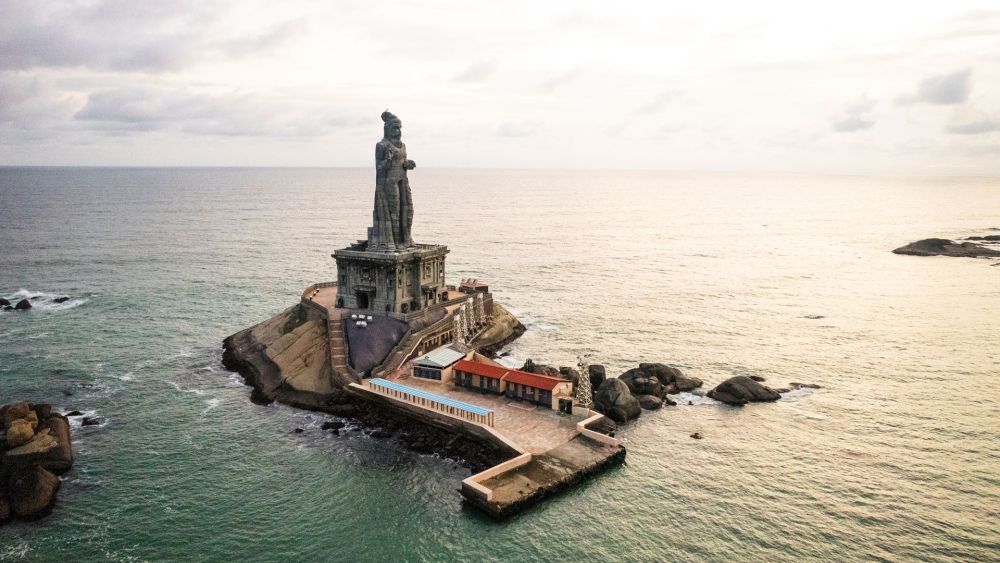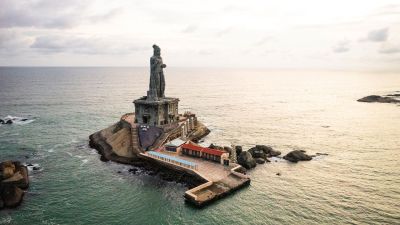

Vivekananda Rock Memorial is a profound architectural beauty situated on a small island off the coast of Kanyakumari, where the Bay of Bengal, Arabian Sea, and Indian Ocean converge. The memorial is dedicated to the revered Indian philosopher Swami Vivekananda, who is said to have attained enlightenment on this very rock. Visitors can access the memorial by a ferry ride, which offers a picturesque view of the sea. Once there, you can explore the meditation hall (Dhyana Mandapam) and the several statues, including the imposing Vivekananda statue, while soaking in the spiritual atmosphere. The place is not just a monumental tribute to a great saint but also offers spectacular sunrise and sunset views from the tip of India.
The Thiruvalluvar Statue stands tall at a height of 133 feet (40.6 meters) and represents the 133 chapters of the 'Thirukkural', an ancient Tamil philosophical text written by Thiruvalluvar. This majestic and towering statue is situated on a small island near the Vivekananda Rock Memorial and is accessible by the same ferry service. The statue, depicting the saint-poet Thiruvalluvar, offers a glimpse into the rich Tamil culture and literature. Visitors can climb up the inside of the pedestal to the feet of the statue for an awe-inspiring view of the surrounding oceans and the nearby Vivekananda Rock.
Padmanabhapuram Palace is an architectural wonder dating back to the 16th century and is situated in the foothills of the Veli Hills. Despite being located in the state of Tamil Nadu, the palace is actually maintained by the neighboring state of Kerala. The palace complex is a stunning example of traditional Kerala architecture with intricate wooden carvings, antique furniture, and unique murals. It once served as the residence of the Travancore Royal Family and today stands as a prominent testimony to South Indian heritage. The palace is a museum that showcases weapons, paintings, and various artifacts from the bygone era, offering visitors a historical voyage through the lives of the royals.
Kanyakumari Beach is renowned for its spectacular sunsets, especially on full moon days when the sun sets and the moon rises simultaneously over the ocean horizon. The beach itself is unique for its multi-colored sand and rocky shoreline offering a breathtaking panorama. Visitors often gather here in the evening to witness the sun dipping into the vast sea, painting the sky with vibrant hues. The lighthouse near the beach provides a panoramic view of the surrounding area and is a perfect spot for taking in the vastness of the ocean. It is a moment of tranquility and beauty that makes for an unforgettable experience, often accompanied by the local vendors selling handicrafts and snacks.
The Kanyakumari Temple, also known as the Bhagavathy Amman Temple, is a 3000-year-old shrine dedicated to the virgin goddess Kanyakumari (a form of Parvati). According to legend, the goddess performed penance here to marry Lord Shiva. The temple, with its beautiful architecture, is located at the confluence of three bodies of water and offers a spiritual experience amidst the resonance of waves. Devotees and tourists flock to the temple, not only for religious reasons but also to feel the essence of calmness and serenity it exudes. The diamond nose ring of the deity is famous for its sparkling glow which is said to be visible even from the sea.
The Tsunami Monument in Kanyakumari is a poignant memorial erected in honor of those who lost their lives in the 2004 Indian Ocean earthquake and tsunami. The monument is designed artistically to symbolize hands reaching out to the sky, signifying the lives lost and the struggle during the catastrophe. It stands as a somber reminder of nature's unpredictable power and the many lives impacted by the disaster. Located by the southern shore, it also serves as a place for silent contemplation about the fragility of human life, while also offering a beautiful view of the sea. The surrounding area is peaceful and provides a space for visitors to pay their respects and reflect.
The Gandhi Memorial Mandapam is an architectural marvel, dedicated to Mahatma Gandhi, located close to the Kanyakumari Temple. After his assassination in 1948, Gandhi's ashes were brought here before a portion was immersed in the confluence of the three seas. The central structure represents the urn that held Gandhi's ashes, and the design allows the sun's rays to fall on the exact spot where the urn was displayed on his birthday, October 2nd. This striking white monument, with its Orissan temple architecture, stands as a solemn tribute to the Father of the Nation. Inside, visitors can see pictures and memorabilia related to Gandhi's life and his visits to the southern region of India.
The Suchindram Thanumalayan Temple, also known as Sthanumalayan Kovil, is a religious site rich in history and culture, located just north of Kanyakumari. Dedicated to a deity that represents the combined forces of Shiva, Vishnu, and Brahma, the temple boasts an exquisite display of Hindu architecture, with its intricately carved sculptures, towering gopuram, and musical pillars that produce various musical notes when struck. The temple holds immense significance for both architectural enthusiasts and spiritual seekers. A visit to Suchindram is often tied with a sense of peace, wonder, and an appreciation for the ancient craftsmanship.
Baywatch Park is Kanyakumari’s answer to an enjoyable water-themed amusement park experience, perfect for families and adventurers alike. Nested near the shores, it offers an array of water rides, dry rides, and attractions, including a Ferris wheel, multiple water slides, wave pools, and more. The park is carefully maintained, and safety is given the utmost priority. Visitors can unwind and cool off while enjoying the various rides and get a dose of adrenaline in their otherwise tranquil Kanyakumari trip. For those traveling with children, this park can provide an engaging break from the historical and cultural explorations of the town.
The Tsunami Museum in Kanyakumari is an emotional and educational homage to the victims of the 2004 Tsunami. Through pictures, articles, and models, the museum narrates the story of the disaster's impact on the coastal town and its people. It showcases the heroic acts of survival, the concerted efforts of the rescue missions, and how the community has since rebuilt itself. The museum serves as a memorial but also as a center for learning, providing insights into tsunami science and the importance of disaster preparedness. Visitors leave not only with a sense of the loss suffered but also with a newfound respect for the power of community resilience in the face of natural disasters.
